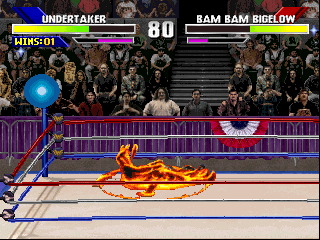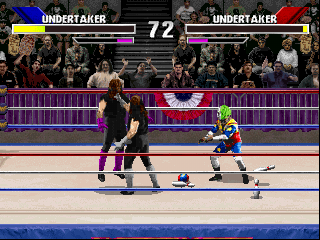Retro Replay Review
Gameplay
WWF WrestleMania: The Arcade Game reshapes the wrestling experience into a head-to-head brawl, borrowing heavily from the mechanics of one-on-one fighters like Mortal Kombat. Each match unfolds across a series of timed rounds rather than standard pinfalls or submissions. To win a round, you simply deplete your opponent’s energy meter, sending them crashing out of the ring. The emphasis on rapid combos and over-the-top special moves keeps the action frantic and accessible, even for players new to wrestling games.
(HEY YOU!! We hope you enjoy! We try not to run ads. So basically, this is a very expensive hobby running this site. Please consider joining us for updates, forums, and more. Network w/ us to make some cash or friends while retro gaming, and you can win some free retro games for posting. Okay, carry on 👍)
The control scheme is streamlined yet surprisingly deep. A simple combination of punches, kicks, grapples, and directional inputs unleashes character-specific finishers. Pulling off move lists is intuitive, but mastering each superstar’s arsenal—ranging from Bret “Hit Man” Hart’s Sharpshooter mimic to Yokozuna’s massive Banzai Drop—requires practice. The pace is relentless, and quick dashes in and out of the ring add a strategic layer, encouraging hit-and-run tactics.
With three main modes—arcade, tournament, and versus—replay value is high. Solo players can tackle a ladder of opponents in arcade mode, culminating in a championship showdown, while tournament mode invites up to eight wrestlers into a bracketed showdown. Versus mode brings the real party energy, allowing friends to square off in instant matches. Although there’s no authentic tag team action, the one-on-one format keeps matches tight and focused.
Despite its arcade roots, the game manages to capture the showmanship of the WWF. Ring entrances are brief but impactful, and signature taunts leave opponents stunned long enough to land critical hits. Special moves are flashy and exaggerated, perfectly matching the larger-than-life personalities on display. In short, the gameplay juggles simplicity with spectacle, providing both pick-up-and-play thrills and room for mastery.
Graphics
Digitized sprites form the visual backbone of WWF WrestleMania: The Arcade Game, giving each superstar a photo-realistic look. Doink’s mischievous grin and The Undertaker’s ominous gait are captured in surprisingly detailed frames. While the resolution is limited by early ’90s technology, the game’s aesthetic still holds up as a faithful time capsule of the era’s arcade style.
Backgrounds are dynamic and varied, ranging from standard ring setups to themed arenas that evoke the WWF’s pay-per-view spectacles. Crowd animation is minimal but effective: pixelated bodies lean forward in anticipation, and the occasional thrown object or banner adds color to the mostly static backdrop. Each ring rope and turnbuckle is fully rendered, creating a convincing play space for high-flying maneuvers.
Special moves trigger zoomed-in cutscenes that highlight the brutality of the action. Razor Ramon’s Razor’s Edge and Bam Bam Bigelow’s Greetings from Asbury Park both receive dramatic camera shifts, complete with quick fades and impact frames reminiscent of fighting games. These moments break up the standard volley of strikes and grapples, adding visual flair to climactic exchanges.
Despite the limitations of digitized imagery—such as occasional sprite pop-in or choppiness during complex moves—the overall presentation remains polished. Character colors are bold and distinct, ensuring that each wrestler stands out against the ring mat. Whether you’re playing on CRT or a modern up-res display, the game’s nostalgic charm is impossible to miss.
Story
As an arcade-style title, WWF WrestleMania: The Arcade Game doesn’t unfold a deep narrative, but it captures the essence of early ’90s WWF storytelling. Each wrestler represents a unique storyline archetype: the arrogant showman (Shawn Michaels), the cold technician (Bret Hart), the unstoppable force (Yokozuna), and the supernatural spectacle (The Undertaker). These personas drive the implicit rivalry structure of the arcade ladder.
Between matches, brief interstitial screens showcase the next challenger entering the ring, complete with a tagline or catchphrase. While there’s no spoken dialogue, character introductions rely on bold text, thematic backdrops, and digitized voice samples. These snippets reinforce the theater of pro wrestling, building anticipation as you climb the ranks toward the ultimate championship match.
Tournament mode adds a pseudo-narrative arc by placing you in a bracket of eight superstars. Each victory brings a different opponent and a fresh ring environment; the final bout often features taunting cutscenes or exaggerated victory poses that simulate championship theatrics. Though simplistic, this structure captures the thrill of progressing through pay-per-view events like WrestleMania itself.
For players seeking deeper lore, external WWF media from the era supplies context for rivalries and alliances. The game functions as a complementary piece rather than a standalone saga: it invites fans to imagine their own matchups and dream feuds. In that regard, WrestleMania: The Arcade Game shines as an interactive highlight reel of WWF’s golden age.
Overall Experience
WWF WrestleMania: The Arcade Game stands as both an arcade relic and a nostalgic celebration of early-90s wrestling. Its fast-paced, quarter-eating matches capture the adrenaline rush of stepping into the ring, while digitized graphics and catchy sound bites immortalize eight iconic superstars. Fans of the era will appreciate the authentic presentation, and newcomers will find the pick-up-and-play nature welcoming.
Multiplayer matches deliver the biggest thrills, as friends duke it out in living rooms or arcade cabinets. The lack of deep simulation is counterbalanced by the unadulterated fun of special moves flying and energy meters ticking down. Tournament mode extends the lifespan for solo players, though repeated playthroughs can feel repetitive once you’ve memorized each wrestler’s patterns.
Sound design, including sampled crowd reactions and signature entrance tunes, elevates the atmosphere. The announcer’s digitized calls reinforce the spectacle, even if they’re occasionally truncated. While finer details—like ring-out recovery times or stamina drains—might frustrate simulation purists, they keep matches brisk and dramatic.
In the final analysis, WWF WrestleMania: The Arcade Game is best enjoyed as a party starter or a nostalgic trip rather than a realistic wrestling simulation. Its hybrid of fighting-game mechanics and pro wrestling flair offers a unique, entertaining package that still resonates decades after its release. For anyone seeking a dose of arcade energy infused with WWF star power, this title remains a worthwhile pick.
 Retro Replay Retro Replay gaming reviews, news, emulation, geek stuff and more!
Retro Replay Retro Replay gaming reviews, news, emulation, geek stuff and more!









Reviews
There are no reviews yet.